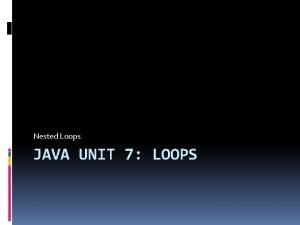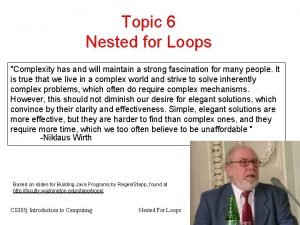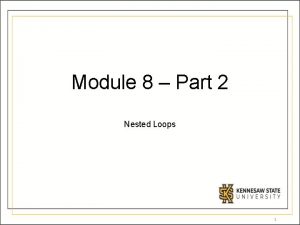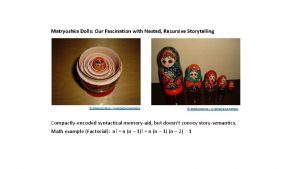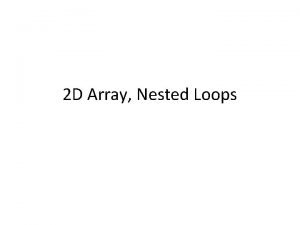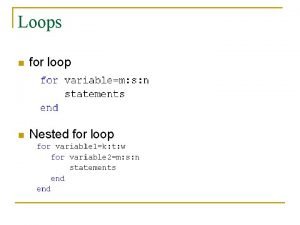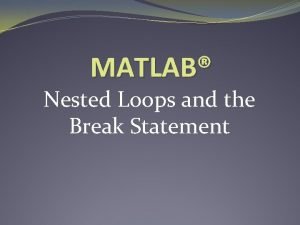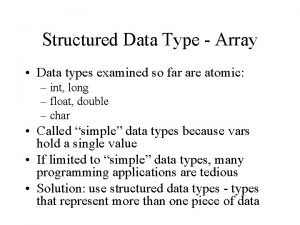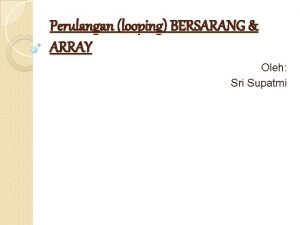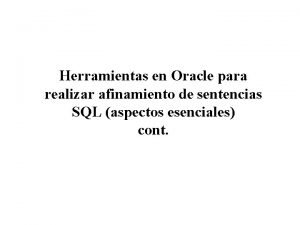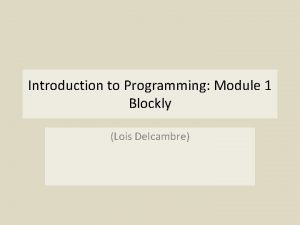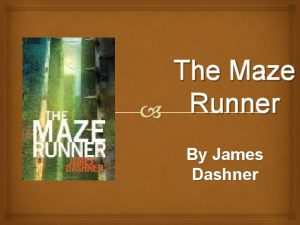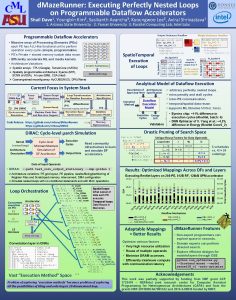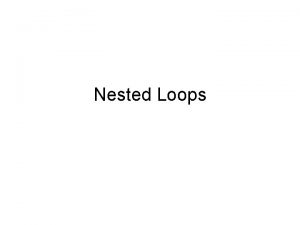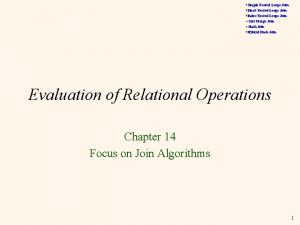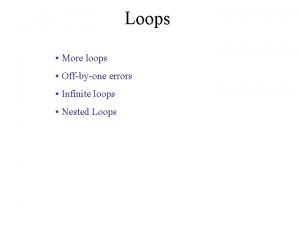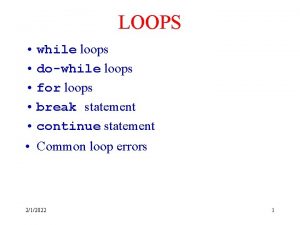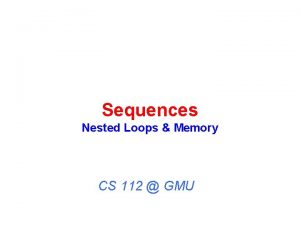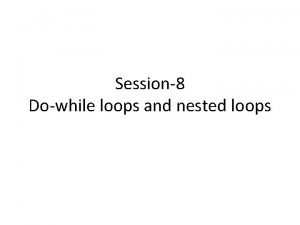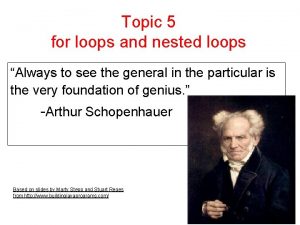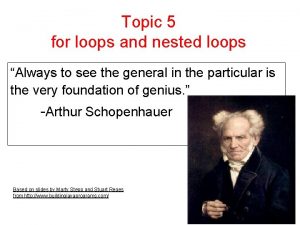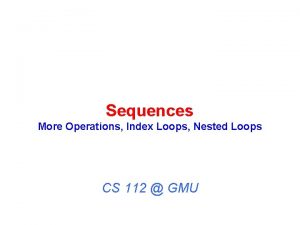d Maze Runner Executing Perfectly Nested Loops on



![Demo: Di. RAC – Cycle-level μarch Sim �Di. RAC Demo 4 [Alpha Release] https: Demo: Di. RAC – Cycle-level μarch Sim �Di. RAC Demo 4 [Alpha Release] https:](https://slidetodoc.com/presentation_image_h/078ae34e44195bd5bcbee8e34f1309ae/image-4.jpg)











- Slides: 15

d. Maze. Runner: Executing Perfectly Nested Loops on Dataflow Accelerators Shail Dave 1, Youngbin Kim 2, Sasikanth Avancha 3, Kyoungwoo Lee 2, Aviral Shrivastava 1 [1] Compiler Microarchitecture Lab, Arizona State University [2] Department of Computer Science, Yonsei University [3] Parallel Computing Lab, Intel Labs M C L

Must-Accelerate Applications in ML Era Widely Used ML Models Multi Layer Perceptrons Convolution Neural Nets Popular Applications � Object Classification/Detection � Media Processing/Generation � Large-Scale Scientific Computing http: //yann. lecun. com/exdb/lenet/ Sequence Models http: //vision 03. csail. mit. edu/cnn_art/index. html https: //pjreddie. com/darknet/ Graph Neural Networks Tropical Cyclon Detection https: //giphy. com https: //insidehpc. com/2019/02/gordon-bellprize-highlights-the-impact-of-ai/ http: //jalammar. github. io/visualizing-neural-machine-translation -mechanics-of-seq 2 seq-models-with-attention/ https: //deeplearning. mit. edu/ Reinforcement Learning Points of Interest Delaunay Triangulation YOW! Data 2018 Conference. https: //www. youtube. com/wat ch? v=l. DRb 3 Cj. ESm. M Alpha. Go. https: //www. nature. com /articles/nature 24270 2 � Designing Software 2. 0 Google shrinks language translation code from 500 k Lo. C to 500 https: //jack-clark. net/2017/10/09/import-ai-63 -google-shrinkslanguage-translation-code-from-500000 -to-500 -lines-with-aionly-25 -of-surveyed-people-believe-automationbetter-jobs/ Kunle Olukotun, Neur. IPS 2018 Invited talk. � and more … M C L

Dataflow Accelerators: Promising Solution Variations known as: - systolic arrays, - spatially programmable architecture, - coarse-grained reconfig. arrays � Massive array of processing elements (PEs). � � Simple: No complex Oo. O pipeline. Programmable: can execute all loop operations. Private & shared memory for PEs sustain data reuse. � PEs can be engaged in computations while data communicated from lower memories. � � Done by effective data management (software prefetching, data distribution and allocation). [1] Norman Jouppi et al. In-datacenter performance analysis of a tensor processing unit. In ISCA 2017. [2] Yu-Hsin Chen et al. Eyeriss: An energy-efficient reconfigurable accelerator for deep cnns. In JSSC 2016 [3] Dataflow Processing Unit from Wave Computing. In HOTCHIPS 2017. [4] M. Thottethodi & T. N. Vijaykumar. Why GPGPU is Less Efficient than TPU for DNNs. ACM SIGARCH Blog, Jan 19. [5] Bruce Fleischer et al. , A Scalable Multi-Tera. OPS Core for AI Training and Inference. In VLSI 2018. [6] Manupa Karunaratne et al. Hycube: A cgra with reconfigurable single-cycle multi-hop interconnect. In DAC 2017. 3 M C L
![Demo Di RAC Cyclelevel μarch Sim Di RAC Demo 4 Alpha Release https Demo: Di. RAC – Cycle-level μarch Sim �Di. RAC Demo 4 [Alpha Release] https:](https://slidetodoc.com/presentation_image_h/078ae34e44195bd5bcbee8e34f1309ae/image-4.jpg)
Demo: Di. RAC – Cycle-level μarch Sim �Di. RAC Demo 4 [Alpha Release] https: //github. com/cmlasu/Di. RAC M C L

Spatiotemporal Execution of Loops Convolution kernel 5 M C L

Loop Orchestration Concurrent execution on PEs L 1 Accesses L 2 Accesses L 3 Accesses Convolution kernel Accelerator Scratch-Pad Memory DRAM (Off-Chip) for n_L 3 = 1: N_DRAM for m_L 3 = 1: M_DRAM for c_L 3 = 1: C_DRAM for ox_L 3 = 1: Ox_DRAM for oy_L 3 = 1: Oy_DRAM for fx_L 3 = 1: Fx_DRAM for fy_L 3 = 1: Fy_DRAM { dma( ); for n_L 2 = 1: N_SPM for m_L 2 = 1: M_SPM for c_L 2 = 1: C_SPM for ox_L 2 = 1: Ox_SPM for oy_L 2 = 1: Oy_SPM for fx_L 2 = 1: Fx_SPM for fy_L 2 = 1: Fy_SPM { communicate_data_No. C( ); for n_L 1 = 1: N_RF for m_L 1 = 1: M_RF for c_L 1 = 1: C_RF for ox_L 1 = 1: Ox_RF for oy_L 1 = 1: Oy_RF for fx_L 1 = 1: Fx_RF for fy_L 1 = 1: Fy_RF { for n_S = 1: N_SPATIAL for m_S = 1: M_SPATIAL for c_S = 1: C_SPATIAL for ox_S = 1: Ox_SPATIAL for oy_S = 1: Oy_SPATIAL for fx_L 3 = 1: Fx_SPATIAL for fy_L 3 = 1: Fy_SPATIAL O[][] += I[][] * W[][]; }}} nested loop capture a vast space All the 7 -deep tilings and orderings of “hardware-software execution methods” of the nested loops on the dataflow accelerator 6 M C L 28 -deep nested loop

Configuring 2 D Spatial Execution for fx_T=1: 3 for fy_T=1: 3 Each PE computes 1 output value out of 9 in 2 D ofmap. #pragma unroll spatial for ox_S=1: 3 O[ox][oy]+= for oy_S=1: 3 W[fx][fy]× O[ox][oy]+= I[ox+fx-1][oy+fy-1]; W[fx][fy]× * I[ox+fx-1][oy+fy-1]; = for ox=1: 3 for oy=1: 3 for fx=1: 3 for fy=1: 3 Loops for Filters execute Temporally on every PE Ofmap channel 1 Fx×Fy=3 x 3 Ox×Oy=3 x 3 = m=1 5 x 5 ifmap filter Oy_Spatial=3 Ox=3 Oy=3 Ox_Spatial=3 * (1, 1) O(1, 1) (1, 2) (1, 3) (2, 1) (2, 2) (2, 3) (3, 1) (3, 2) (3, 3) PE(1, 1) computes O(1, 1), PE(1, 2) computes O(1, 2), and so on 7 Output Stationary Dataflow Mechanism M C L

Different tiling → Different dataflow for ox=1: 3 for oy=1: 3 for fx=1: 3 for fy=1: 3 for ox_T=1: 3 for oy_T=1: 3 Loops for Ofmaps execute Temporally on every PE #pragma unroll spatial for fx_S=1: 3 O[ox][oy]+= for fy_S=1: 3 W[fx][fy]× O[ox][oy]+= I[ox+fx-1][oy+fy-1]; W[fx][fy]× O I[ox+fx-1][oy+fy-1]; Ofmap channel 1 Fx×Fy=3 x 3 Ox×Oy=3 x 3 m=1 5 x 5 ifmap filter Ox=3 Oy=3 Each PE computes 1 MAC out of 9 for each output value. 8 Fx_Spatial=3 = * O(m, 1, 1) Fy_Spatial=3 (1, 1) P 1 (1, 2) P 2 (1, 3) P 3 (2, 1) P 4 (2, 2) P 5 (2, 3) P 6 (3, 1) P 7 (3, 2) P 8 (3, 3) P 9 P 1 + P 2 + … + P 9 = O(1, 1, 1) Weight Stationary Dataflow Mechanism M C L

Modeling Dataflow Execution Features with detailed modeling of ü Analyze arbitrary perfectly nested loops. ü miss penalty and stall cycles (PE execution, managing PE’s private and shared memory). ü inter-PE communication. ü temporal/spatial data reuse. Step-wise equations and analysis in the paper 9 ü Integrated support for common ML libraries MXNet, Keras, etc. (leveraging TVM front-end) M C L

Validation of Execution Model Validation against DNN Optimizer of Yang et al. • Energy estimate differs by ~4. 2% for various execution methods • For efficient mappings, major energy spent in RF accesses Yang, Xuan, M. Gao, J. Pu, A. Nayak, Q. Liu, S. Bell, J. Setter, K. Cao, H. Ha, Christos Kozyrakis, and Mark Horowitz. "DNN Dataflow Choice Is Overrated. " [ar. Xiv ‘ 18] Validation against Eyeriss Chip ~11% perf. difference vs. real-chip execution 10 Chen, Yu-Hsin et al. "Eyeriss: An energy-efficient reconfigurable accelerator for deep convolutional neural networks. " [JSSC ’ 17] M C L

Results: 9 X reduction in EDP 11 Output Stationary Weight Stationary Row Stationary Coarse Weight Stationary Total Execution Cycles EDP (Energy-Delay Product) Executing Res. Net layers on 256 -PE, 512 B RF, 128 k. B SPM dataflow accelerator M C L

Demo: d. Maze. Runner �d. Maze. Runner Demo 12 Release: https: //github. com/cmlasu/d. Maze. Runner M C L

Drastic Pruning of Search Space Example: Generating loop-orderings with unique data reuse factors for n = 1: N=2 for m = 1: M=8 for c = 1: C=4 for fy = 1: Fy=3 { comm_data(); O[n][m]+= I[n][c][fy]× W[m][c][fy] } 5 schedules with unique reuse costs as compared to 4! = 24 schedules Unique Reuse Factors for Data Operands invariant of loops with index variables O I W 13 c, fy m n Loops with index variables ‘c' and ‘fy’ are innermost. Operand ‘O’ reused across both loops - 2*8*4*3 accesses total - O is accessed only 2*8 times M C L

Adaptable Mappings Yield Better Results � Adapts to kernel/arch characteristics � Scales for layers/tensors of different shapes � Finds non-intuitive mappings that optimizes various factors e. g. , Example Mappings of Res. Net Conv 5_2 for Output-Stationary Dataflow ü High resource utilization ü Maximized reuse of multiple data operands ü Minimized DRAM accesses ü Efficient interleaving of computation with communication latency For data allocated in RFs of PEs, MOC d. Mz. Rnr PE Compute vs. Data comm. Latency: 144 vs. 648 576 vs. 576 Total cycles: ~10, 616, 832 ~2, 459, 648 Ideal execution cycles for output-stationary: 2, 359, 296 Reduction in DRAM accesses (ifmaps, weights): (1 x, 1 x) (4. 57 x, 2 x) Perf. improvement (normalized to MOC): 1 x 4. 44 x Energy-Delay-Product reduction (normalized): 1 x 9. 86 x MOC: Simultaneous spatial processing of Multiple Output Channels [1] S. Gupta et al. Deep learning with limited numerical precision. In ICML, 2015. [2] Y. Chen et al. Eyeriss: A spatial architecture for energy-efficient dataflow for CNNs. In ISCA 2016. 14 M C L

Conclusions � Dataflow accelerators: promising for ML applications. � Di. RAC: Cycle-level microarchitecture simulation of executing nested loops on dataflow accelerators. � Need to determine efficient “execution method” for spatiotemporal executions on dataflow accelerators � d. Maze. Runner: Automated, succinct, and fast exploration of mapping search space and architecture design space � Adaptive and non-intuitive mappings enable efficient dataflow acceleration 15 M C L
 Nested loops java
Nested loops java Nested loop complexity
Nested loop complexity Space complexity vs time complexity
Space complexity vs time complexity Perulangan looping
Perulangan looping Pseudocode nested loop example
Pseudocode nested loop example Nested loops storytelling
Nested loops storytelling Nested loops python
Nested loops python N nested for loops
N nested for loops Break statement matlab
Break statement matlab Structured text array
Structured text array Array bersarang
Array bersarang Oracle plan de ejecucion
Oracle plan de ejecucion Dame meaning in baa black sheep
Dame meaning in baa black sheep Beetle blade maze runner
Beetle blade maze runner What is the theme of the maze runner
What is the theme of the maze runner What is zone control system in driving
What is zone control system in driving
